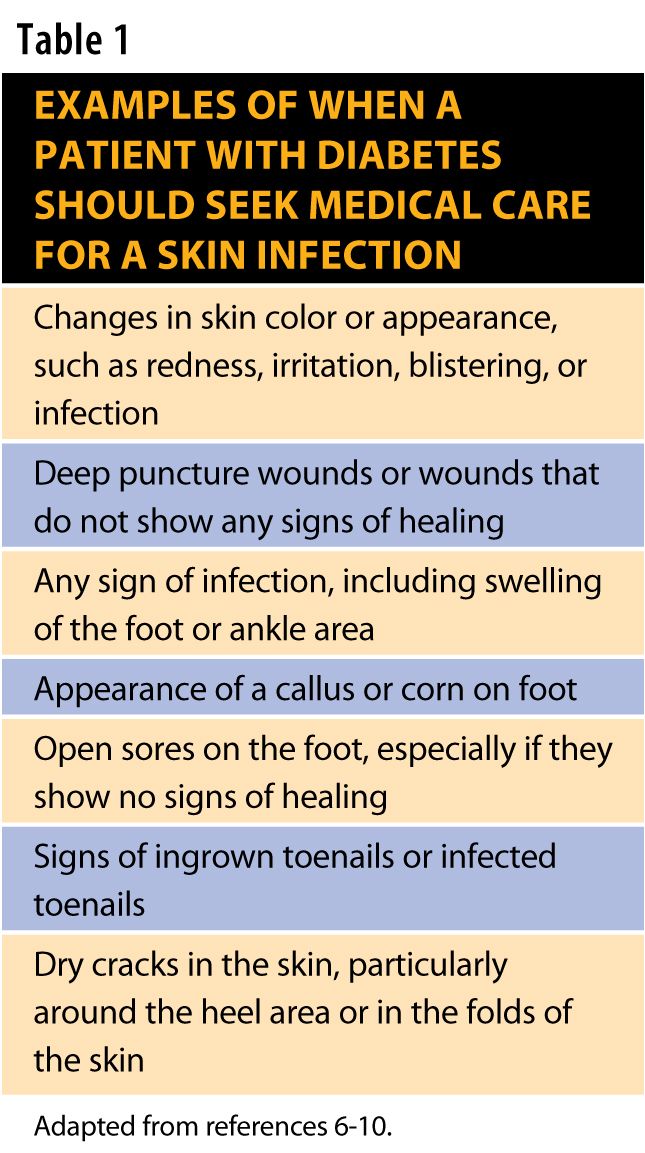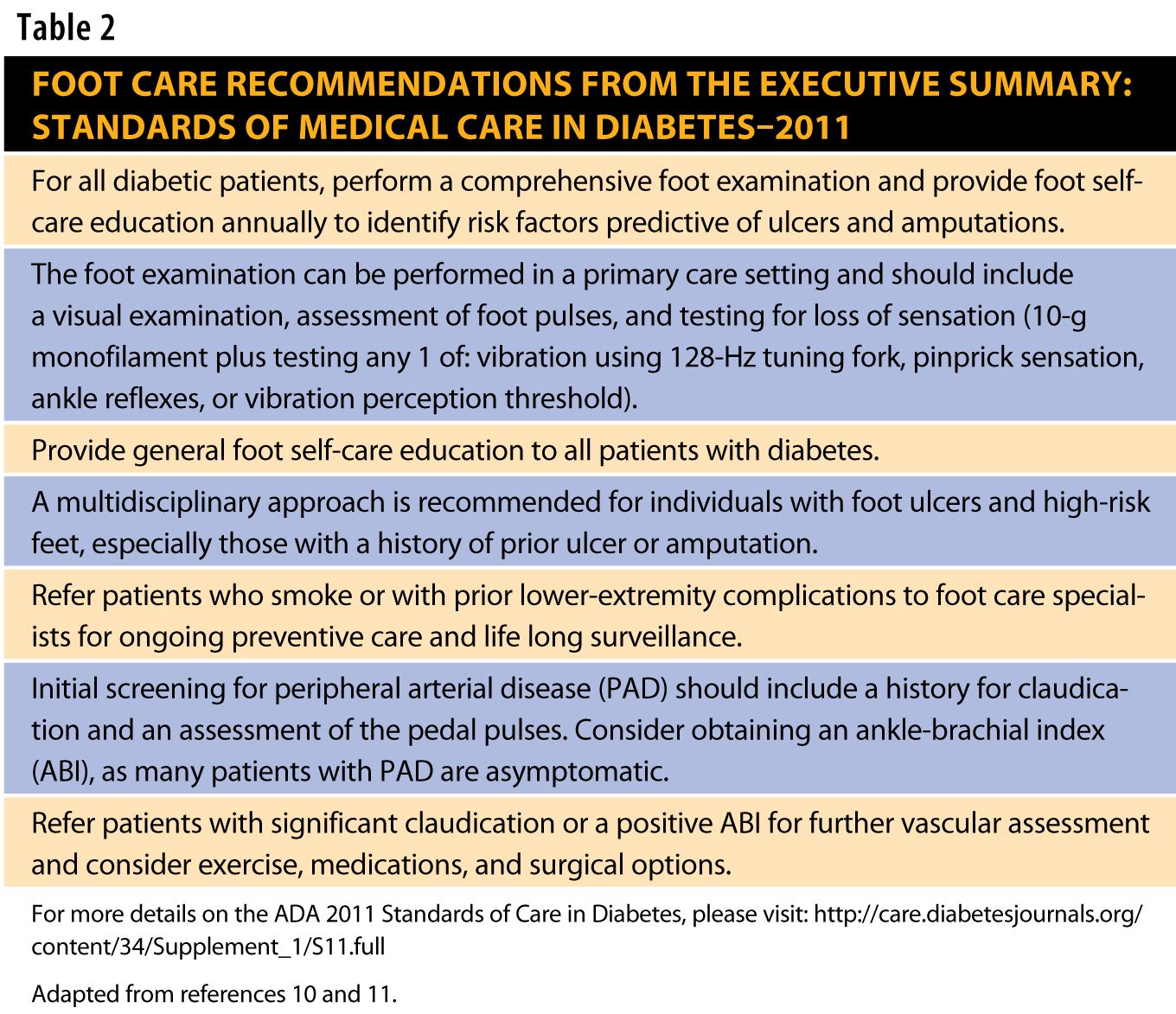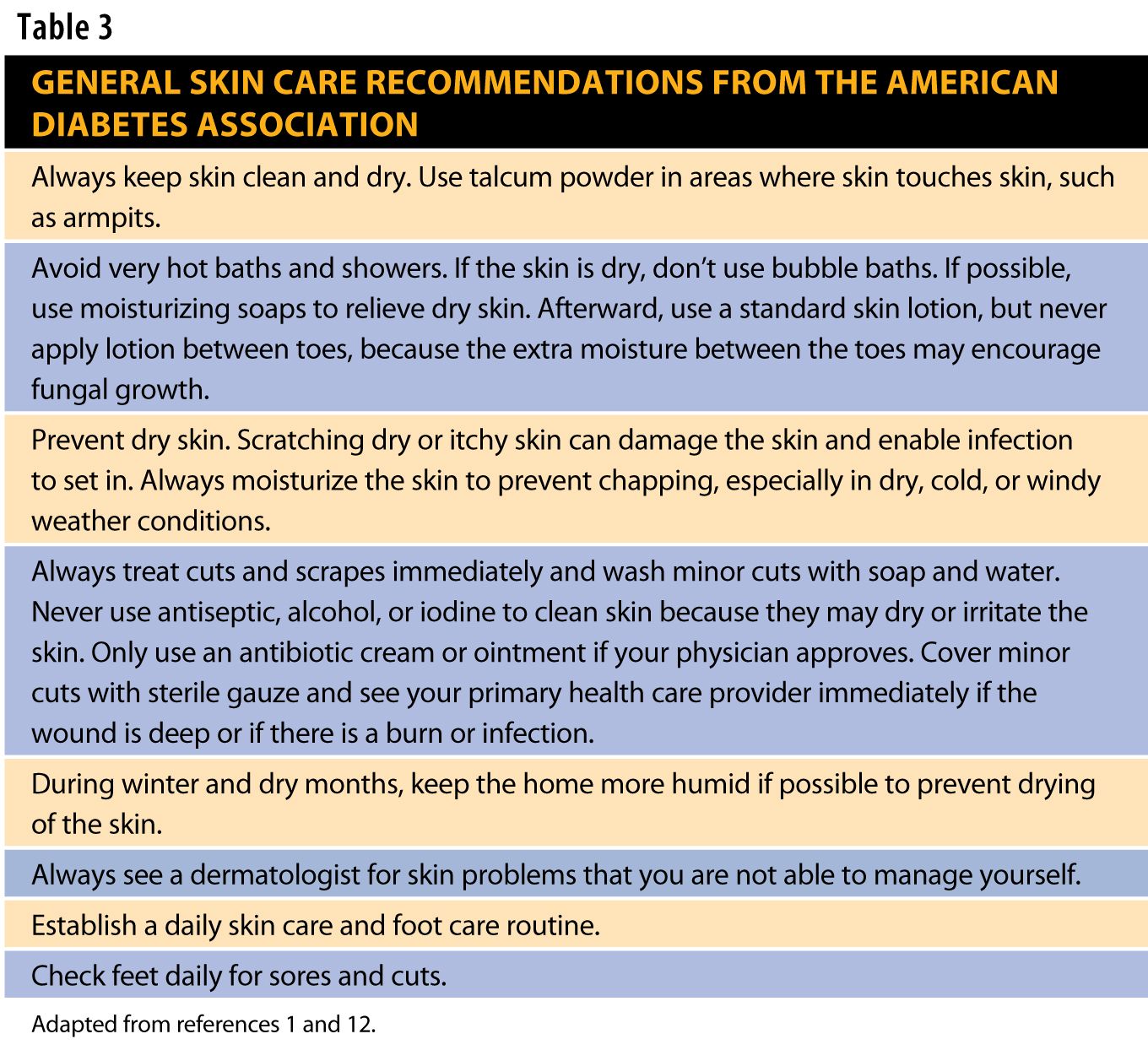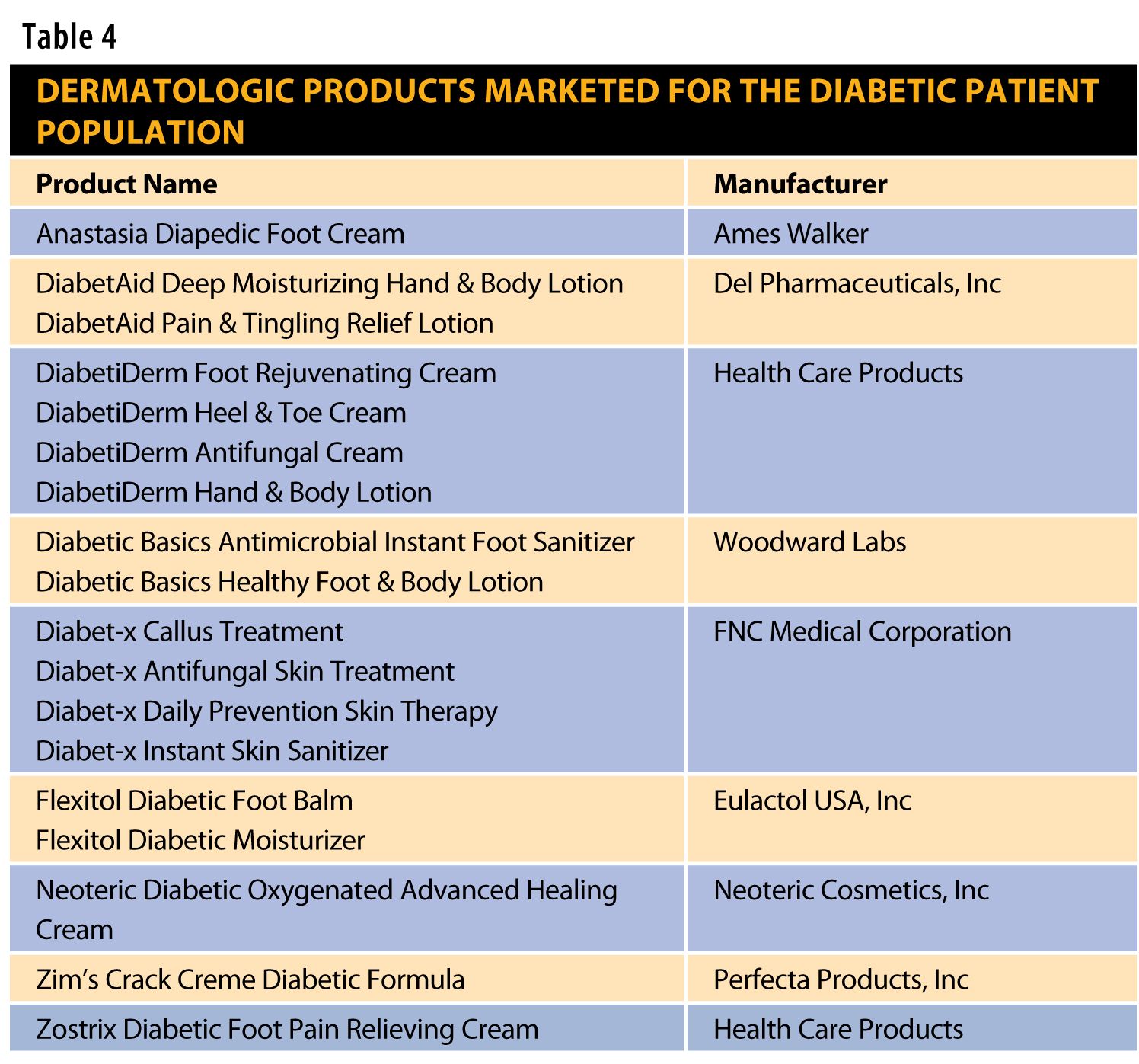Publication
Article
Pharmacy Times
Managing Skin Complications in Patients with Diabetes
Author(s):
Individuals with diabetes should not overlook preventive skin care as part of their diabetes management routine.
Individuals with diabetes should not overlook preventive skin care as part of their diabetes management routine.

Although anyone can develop dermatologic conditions, individuals with diabetes—especially those with poorly controlled diabetes—are more susceptible to skin-related complications. The American Diabetes Association (ADA) estimates that 33% of the diabetic patient population will develop some type of skin disorder that is caused or affected by diabetes.1 In some cases, the development of skin-related problems may actually be the first indication that an individual has diabetes.1
Fortunately, many of these skin conditions are manageable. Through patient education, early detection, and proper management of independent risk factors, diabetes-related skin complications can be reduced or prevented, and the risk of further complications may decrease.2-4 The main components of diabetic skin care include preventive strategies focused on prophylactic skin care, foot care, and nail care, and increased emphasis on the importance of maintaining tight glycemic control and adhering to a skin care regimen.2
As one of the most accessible health care professionals, the pharmacist is in a pivotal position to educate diabetic patients on the benefits of routine skin care, including daily foot care and screenings designed to prevent complications such as bacterial and fungal infections and foot ulcers, which may ultimately lead to an amputation if left untreated.
Common Skin Infections and Complications
Some examples of bacterial skin infections that commonly occur in patients with diabetes include styes, boils, folliculitis, carbuncles, and infections around the nails. 4 The most commonly occurring pathogen causing bacterial skin infections is Staphylococcus bacteria.4
Athlete’s foot and ringworm caused by Candida albicans are 2 types of fungal infections4 that can cause patients to develop itchy, red, and moist areas on the skin that are surrounded by tiny blisters and scales. These infections often occur in the warm, moist folds of the skin.4
In addition to bacterial and fungal infections, individuals with diabetes are more likely to experience itchy skin, which is thought to be caused by dryness or poor circulation. 4 Other skin problems that occur primarily in patients with diabetes include diabetic dermopathy, necrobiosis lipoidica diabeticorum, diabetic blisters, and eruptive xanthomatosis.4

Individuals with diabetes are also at a greater risk for developing foot-related complications, such as changes in the skin (dryness and itching) and foot ulcers. These complications are common and can often be attributed to vascular disease, neuropathy, and relative immunosuppression.5 Examples of common foot problems that could possibly lead to infection and serious complications in patients with diabetes include6-10:
- Athlete’s foot
- Fungal infection of the nails
- Corns and calluses
- Dry, cracked skin
- Blisters
- Foot ulcers
- Hammertoes and bunions
- Ingrown toenails
- Plantar warts
Patients should be encouraged to discuss possible skin-related complications with their primary health care provider, who can help them learn how to recognize and manage these conditions.
Counseling Points

When counseling diabetic patients on their medications, pharmacists should discuss nonprescription dermatologic products that address the specific skin care needs of this patient population, including antimicrobial lotions, skin moisturizers, antifungal and callus treatments, and powder and alcohol-free foot sanitizers. Patients should be encouraged to seek immediate medical care when warranted (Table 1) to avoid further complications.
Many experts believe that individuals with diabetes can significantly decrease the risk of skin infections and complications by practicing routine skin care.4 Data from the National Institutes of Health Diabetes Information Clearinghouse indicate that comprehensive foot care programs—which include foot care education, risk assessment, and preventive therapy—may decrease amputation rates by 45% to 85%.9
In the 2011 Standards of Medicare Care in Diabetes, the ADA recommends that all patients with diabetes receive an annual foot exam (a summary of the recommendations for foot care can be found in Table 2). The ADA has also issued general skin care recommendations (Table 3) to decrease the risk of skin-related diabetes complications.
Finally, when assisting patients in the selection of skin care products (Table 4), it is also important that pharmacists provide patients with key information on proper diabetic foot care. 5-8 A number of patient education resources can be found on the ADA’s homepage and at the Web site for the National Diabetes Education Program. PT
Ms. Terrie is a clinical pharmacy writer based in Haymarket, Virginia.

Table 5: Recommendations for Daily Diabetic Foot Care
- Inspect feet daily including the tops, sides, heels, and between the toes.
- When inspecting, look for cuts, cracks, splinters, blisters, and calluses on the feet. Always contact your primary healthcare provider if wounds show no signs of healing.
- Wash feet in warm (not hot) water daily, and to prevent infections, make sure the feet are thoroughly dry, especially between the toes.
- When trimming toenails, cut straight across and slightly round the edges with an emery board.
- To prevent drying and cracking of the skin, use lotion on the tops and bottoms of the feet.
- Do not apply a hot water bottle or heating pad to feet.
- Wear soft, dry cotton, synthetic blend, or wool socks to absorb moisture, and always wear supportive, enclosed shoes that fit well and protect your feet.
- Wear shoes that are made out of leather, canvas, or suede and are easily adjustable. Do not wear shoes made out of plastic or another material that does not breathe. Make sure shoes fit properly.
- To promote circulation to the lower limbs, prop your feet up when seated and avoid standing in one position for long periods of time.
- Adhere to the prescribed medication schedule and monitor blood glucose routinely to ensure glycemic control.
- Do not attempt to remove corns or calluses without seeking the advice of your primary health care provider.
- Do not use antiseptic solutions to your feet, since these agents may burn or injure skin.
- To prevent foot injuries, do not walk barefoot, especially outdoors.
- Immediately report any sores or skin changes such as blisters, cuts, or soreness to your primary healthcare provider.
- Do not smoke. Smoking accelerates damage to blood vessels, especially small blood vessels leading to poor circulation, which is a major risk factor for foot infections, and ultimately, amputations.
- Always check your shoes for foreign objects before putting them on.
Adapted from references 5-8 and 12.
References
- Skin care. American Diabetes Association Web site. www.diabetes.org/living-with-diabetes/complications/skin-care.html. Accessed August 25, 2011.
- Pinzur M. Diabetic foot. eMedicine Web site. Accessed August 25, 2011.
- Preventive foot care in diabetes.Diabetes Care.2004;27(suppl 1). http://care.diabetesjournals.org/content/27/suppl_1/s63.full.pdf. Accessed August 22, 2011.
- Living with diabetes: skin complications. American Diabetes Association Web site. www.diabetes.org/living-with-diabetes/complications/skin-complications.html. Accessed August 28, 2011.
- Diabetes mellitus. Merck Manual for Healthcare Professionals Online Edition. www.merckmanuals.com/professional/sec13/ch169/ch169a.html. Accessed August 22, 2011.
- Foot complications. American Diabetes Association Web site. www.footphysicians.com/footankleinfo/diabetic-amputations.htm. Accessed August 23, 2011.
- Diabetes foot care. Medline Plus Web site. www.nlm.nih.gov/medlineplus/ency/article/003937.htm. Accessed August 25, 2011.
- Foot and skin related complications of diabetes. Cleveland Clinic Web site.http://my.clevelandclinic.org/disorders/diabetes_mellitus/hic_foot_and_skin_related_complications_of_diabetes.aspx. Accessed August 28, 2011.
- Preventative care practices for eyes, feet and kidneys. National Institute of Diabetes and Digestive and Kidney Diseases Web site. http://diabetes.niddk.nih.gov/dm/pubs/statistics/#Other. Accessed August 28, 2011.
- Foot care. American Diabetes Association Web site. www.diabetes.org/living-with-diabetes/complications/foot-care.html. August 28, 2011.
- Standards of Medical Care in Diabetes 2011. American Diabetes Association Web site. http://care.diabetesjournals.org/content/34/Supplement_1/S11.full. Accessed August 28, 2011.
- Assemi M, Morello C. Diabetes mellitus. In: Berardi R, Newton G, McDermott JH, et al. Handbook of Nonprescription Drugs. 16th ed. Washington, DC: American Pharmacists Association; 2009:841.







